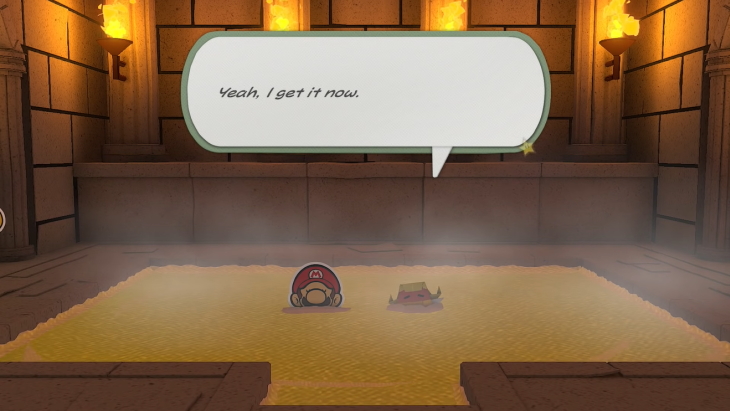
Paper Mario: The Origami King producer Kensuke Tanabe has discussed more regarding the controversial restrictions on the series’ character designs, explaining how “it has become that much more important to convey their personalities simply through text.”
Some fans of the series had taken issue with how ever since Paper Mario: Sticker Star, there seemed to be less variety in the designs of characters and NPCs.
The first game, Thousand Year Door, and Super Paper Mario had the Toads and other classic Mario characters in unique costumes, along with entirely new races to the Mario universe.
However, in Paper Mario: Sticker Star, all Toads looked identical. Fans found that Color Splash featured more “generic” Toads, and the standard staple of Mario characters in their usual designs. This likely aided the mixed and luke-warm reaction gamers had to both titles [1, 2].
The “generic Toad” has almost become a symbol of the issues fans have with the modern Paper Mario games- accusations of simplified stories and moving away from being a true RPG- compared to the extremely positive reception of prior games [1, 2, 3].
This only grew worse after comments made by Tanabe during an interview with Video Games Chronicle (VGC). Therein, Tanabe stated “it’s no longer possible to modify Mario characters or to create original characters that touch on the Mario universe.” You can find the full statement below.
VGC: “Mario is famous for its iconic cast of villains. Can you talk about the new villain in this game and how you design a character to stand alongside all-time greats like Bowser and Kamek?”
Tanabe: “Since Paper Mario: Sticker Star, it’s no longer possible to modify Mario characters or to create original characters that touch on the Mario universe. That means that if we aren’t using Mario characters for bosses, we need to create original characters with designs that don’t involve the Mario universe at all, like we’ve done with Olly and the stationery bosses.
Whether a character becomes an all-time hit or not isn’t up to us on the development side; I think it’s more the case that characters that fans truly accept naturally end up that way. I hope that the origami siblings in Paper Mario: The Origami King will stay in players’ memories, even if they do only end up appearing in this title.”
Tanabe also took part in an interview with Games Radar, the day after the VGC one (thanks VGC). There, Tanabe explained again that there was a limit on how the Toads could be designed. However, he then focused on the importance of the game’s writing to make them more memorable, as well as the inspiration behind Olivia’s personality.
You can find Games Radar’s question and Tanabe’s answer below.
Games Radar: “It’s so lovely to see that The Origami King continues the series’ trend of dialling in on humour. A lot of the humour comes through in your interactions with NPCs in the world and the companions that will follow you on your journey, so how did you approach that with regards to returning favourites and new characters like Olivia?”
Tanabe: “From the production of Paper Mario: Sticker Star onwards, we were no longer able to graphically represent individual characteristics, such as age, gender etc., in the Toad NPCs (non-playable characters), and so it has become that much more important to convey their personalities simply through text. Our writer, Mr Taro Kudo, has been grappling with this difficult challenge since Paper Mario: Sticker Star, but has managed to achieve giving all the texts a sense of humour. In this instalment [sic], Paper Mario: The Origami King, we were able to include some Toads wearing an outfit to match their role, and also created original origami characters.
For the personality of Mario’s travelling companion, Olivia, we were aiming for a particular style. The majority of navigator characters are always smart and guide players as if they were teachers. This means these characters are prone to all have the same kind of personality. What we wanted to do in Paper Mario: The Origami King was to come up with a female character who is somewhat easy-going and charming in their own cheeky way.
Personally, I modelled her on a certain Japanese actress and so I asked Mr Kudo to write her text with that in mind. During the early stages of development, it was a lot of effort for Mr Kudo, but by the end it was almost as if Olivia was writing her own lines! I’m confident she’s turned out to be a really charming character.”
Tanabe also elaborated on why the game utilized realistic stationary as some of the game’s bosses. “For the stationery that appears in this title, we’ve chosen objects that everyone will have interacted with at some point in their lives. I suspect there are more than a few players out there who played make-believe with these objects during their childhoods.”
“When we were working out the battle plans for the different bosses,” Tanabe explains, “we started by going back to our childhoods to broaden our imagination and think about what sort of attacks the stationary would have, and where their weaknesses would be, based on their features or shapes.”
“In that sense, the initial conceptual phase was a lot of fun with all the different stationery.” Tanabe further explains how when it came to implementing these designs “they all posed different challenges because each of their attacks were completely unique.”
Paper Mario: The Origami King is available now on Nintendo Switch. In case you missed it, you can find our review here.
Image: YouTube